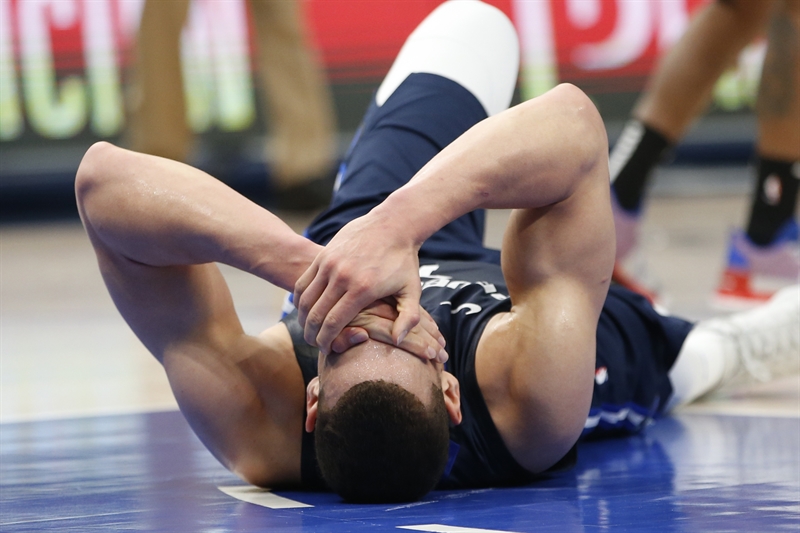You are viewing 1 of your 1 free articles
Beyond 11+: How to design a meaningful injury prevention program

Sports injury results in real economic costs for participants (hospitalization, doctor’s appointments, physiotherapy), as well as time off from work and school for participants hurt while playing sport. In professional sport, the stakes are even higher! Injured players negatively impact team performance, affects revenue, and the job security of players, coaches, and staff. No one wins when players are injured(1).
Despite the apparent importance of injury prevention, many sports professionals are reluctant to engage in injury-prevention activities(2,3). A probable reason for the resistance is that injury prevention requires an investment in the form of time and energy, but doesn’t provide a tangible outcome. Success in injury prevention is a non-event! In this way, injury prevention is a grudge purchase, much like buying car insurance. You pay for it, but then spend the whole year hoping that an accident doesn’t happen. When it doesn’t, you wonder whether the investment was worth it at all!
Prevention isn’t insurance
But injury prevention is not insurance; it is a strategy for mitigating risk! When you crash your car, you get a nice payout that makes things a little better. When a sports injury occurs, it means that you were not able to overcome the exposure risk. You are left regretting the cost of the hours spent on prevention strategies that ultimately didn’t stop the injury. Injury prevention is paying for additional driving lessons to make you a better driver, but it doesn’t protect against getting rear-ended when you’re stopped at a red light.Injury prevention is a tough sell because while it may make the team safer, it ultimately doesn’t protect against injury. This uncertainty doesn’t mean that it is a futile exercise; it just means that to be successful, one needs a good understanding of the parameters of the problem. Two key concepts integral for finding practical solutions are 1) complex systems and 2) wicked problems.
Complex systems
A recent advance in our understanding of injury causation is that injuries usually can’t be explained by linear cause and effect relationships. For example, the presence of over-pronation in a runner doesn’t guarantee that a running injury will occur. Instead, injuries emerge from interactions among a complex web of determinants (see figure 1)(4). Within this complex system, the constituent components all interact with each other and self-organize in ways that are usually difficult to predict. Complex systems tend to behave in a dynamic and non-linear fashion, which makes working within them inherently uncertain.Attempting to reduce injury risk leads to three problems:
- The effect of any injury prevention intervention is uncertain – it is hard to work out what will work in a particular context.
- Transferability is unclear – an injury prevention program that worked in another environment is not guaranteed to work in the present environment.
- The system evolves – interventions that worked in the past may not be successful in the future.
Figure 1 – Example of a complex web of determinants that could result in a rugby tackle injury

Adapted from Bittencourt et al; Br J Sports Med. 2016 Nov;50(21):1309-1314
Wicked problems
Due to the complex nature of injury occurrence, it will never be possible to eradicate injuries. Some specialists believe we should stop using the term ‘injury prevention’ since this is impossible and use the term ‘injury reduction’ instead. When problems such as these are unique to a particular context and have no right or wrong solution, they are called wicked problems (see figure 2)(5).Figure 2: Characteristics of wicked problems

Adapted from Rittel et al; 1973
The defining characteristic of wicked problems is that they can never be finally solved; they result from multi-causal and interconnected factors (complex systems) and usually involve stakeholders with conflicting agendas. For example, reducing training time may improve injury risk, but could affect athletic performance. As a result, solutions to wicked problems can never be considered correct; rather, they are better or worse, depending on the perceptions of various stakeholders.
The benefits of sports participation outweigh the risk, so the goal is to encourage people to play sport with as little risk as possible. In this context, injury prevention interventions usually implement activities that are ‘good enough’ yet fit in with the existing larger sport system. The concept becomes a quest for the most significant impact with the smallest disruption.
So what do we do about it?
How to promote injury prevention in the context of complex systems and wicked problems? The first step is to realize that while these problems are challenging, they are not unique. Most industries exist within complex systems, which create wicked problems requiring management. An example of this is the software industry, which must quickly develop products for a complex and unpredictable market. To overcome this challenge, software companies universally adopt a prototyping model. They design a rough and ready application (knowing that it isn’t perfect) and give it to users to test out and provide feedback. Through this process, they overcome a number of problems associated with complex systems and wicked problems.Complex systems are unpredictable, but the usefulness of a product can be tested on a small scale before being mass-produced. Wicked problems are difficult to solve because of conflicting agendas. However, providing all stakeholders with an opportunity to experiment with a solution gives them a chance to determine what best satisfies their needs. Engaging in iterative prototyping cycles allows designers to learn from previous mistakes and to improve their product in response to evolving markets.
Harnessing prototyping for injury prevention
To many people, injury prevention is formulaic – eg completing the FIFA 11+ as a warm-up before activity, or ensuring that the players’ acute:chronic workloads remain within the ‘sweet-spot.’ However, these formulaic solutions become problematic if they are not a good fit for their environment.A better approach could be the one proposed by the team sport injury prevention (TIP) cycle (see figure 3)(6). In this model, practitioners are encouraged to evaluate the injury profile of their team by conducting injury surveillance. This data allows practitioners to understand their team as an independent complex system with particular playing personnel, game style, and training preferences, and as a result, a unique risk profile. Following this evaluation, practitioners identify the injuries and potential mechanisms that pose the most significant risk to their team and then intervene by putting preventative measures in place.
Figure 3: The Team Sport Injury Prevention Cycle*

The TIP cycle was developed by Barcelona FC as part of their 2018 Muscle Injury Guide, and is specifically aimed at the sports clinician/practitioner. By progressing through the three phases, teams can develop a dynamic and context-specific approach. *(used with permission from Dr James O’Brian)(7)
For example, hamstrings strains are among the most common injuries in football(8), and Nordic hamstring curls are an especially effective exercise for reducing hamstring injury incidence(9). So should your team implement Nordics as part of their training regimen? The answer to this question depends on whether your team regularly suffers hamstring injuries. If so, this may be a useful intervention. If not, introducing an additional exercise may upset the delicate balance of the current training system.
Perhaps a team doesn’t suffer many hamstring injuries because of the volume of high-speed running training that supports the coach’s counter-attacking style. In this context, adding Nordic hamstring drills to the program could result in unnecessary fatigue, which increases the number of injuries that occur. In other words, to make the injury prevention effort worthwhile, the needs of the team must drive the program. This approach ensures that athletes aren’t spending time and energy trying to mitigate against events that are low risk.
Establishing injury-prevention interventions isn’t a ‘one and done’ endeavor. Sport systems continue to evolve and change over time. Therefore, it is important to keep repeating the TIP cycle. Coaches come and go, and their tactics change over time. Players get older, and their training capacity fluctuates. Responsiveness to these changes and the injury problems that emerge requires continuous assessment of injury outcomes in the current context. Injury prevention is a process that evolves through multiple cycles, rather than a once-off intervention(10).
Establishing injury prevention programs in this way targets and responds to the needs of the end-users – the players and coaches. While the outlay of time and resources spent on injury prevention is likely to feel like a grudge purchase, make the expenditure specific to the athlete’s needs by tailoring it to their particular context. This responsiveness removes ineffective interventions and streamlines programs. Thus, the effort and resources spent on injury prevention produce measurable results for athletes.
References
- Br J Sports Med. 2017 Aug; 51(16):1209-14
- Br J Sports Med. 2015 Nov; 49(22):1466-71
- J Sports Sci. 2018 Jul; 36(13):1542-1548
- Br J Sports Med. 2016 Nov; 50(21):1309-1314
- Policy Sciences 1973 Jun; 4(2):155-69
- Science and Medicine in Football 2019 Jan;3(1):77-80.
- O’Brian et al 2018; Sci Med Football. doi.org/10.1080/24733938.2018.1512752
- Scand. J Med Sci Sports, 2008 Feb;18(1):40-48
- Am. J Sports Med, 2011 Nov; 39(11):2296-2303
- Sports Med, 2019 Nov; doi: 10.1007/s40279-019-01232-4
Newsletter Sign Up
Subscriber Testimonials
Dr. Alexandra Fandetti-Robin, Back & Body Chiropractic
Elspeth Cowell MSCh DpodM SRCh HCPC reg
William Hunter, Nuffield Health
Newsletter Sign Up
Coaches Testimonials
Dr. Alexandra Fandetti-Robin, Back & Body Chiropractic
Elspeth Cowell MSCh DpodM SRCh HCPC reg
William Hunter, Nuffield Health
Be at the leading edge of sports injury management
Our international team of qualified experts (see above) spend hours poring over scores of technical journals and medical papers that even the most interested professionals don't have time to read.
For 17 years, we've helped hard-working physiotherapists and sports professionals like you, overwhelmed by the vast amount of new research, bring science to their treatment. Sports Injury Bulletin is the ideal resource for practitioners too busy to cull through all the monthly journals to find meaningful and applicable studies.
*includes 3 coaching manuals
Get Inspired
All the latest techniques and approaches
Sports Injury Bulletin brings together a worldwide panel of experts – including physiotherapists, doctors, researchers and sports scientists. Together we deliver everything you need to help your clients avoid – or recover as quickly as possible from – injuries.
We strip away the scientific jargon and deliver you easy-to-follow training exercises, nutrition tips, psychological strategies and recovery programmes and exercises in plain English.










